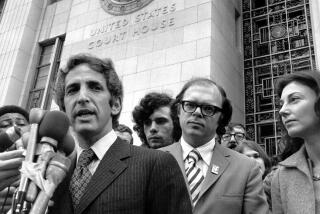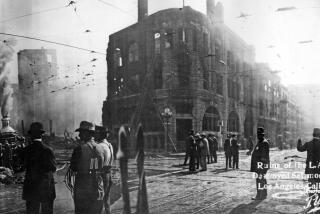Arthur Ochs Sulzberger dies at 86; former New York Times publisher
Arthur Ochs Sulzberger, the fourth publisher of the New York Times, who made history with his decision to publish the Pentagon Papers and revived the “Good Gray Lady” of print journalism with a radical redesign that set a new standard, has died. He was 86.
His death Saturday at his home in Southampton, N.Y., after a long illness, was announced by his son and the current publisher, Arthur O. Sulzberger Jr.
Widely known by the nickname Punch, the senior Sulzberger was publisher of the Times from 1963 to 1992 and chairman and chief executive of the parent company from 1973 to 1997.
Gay Talese, who was a reporter at the paper when Sulzberger took over and wrote a history of the Times in his 1969 book “The Kingdom and the Power,” told the Associated Press that he was “a brilliant publisher. He far exceeded the achievements of his father in both making the paper better and more profitable at a time when papers are not as good as they used to be.”
At 37 — the youngest publisher in the newspaper’s history — he quickly proved himself capable of decisive leadership. Just months into his tenure, he stood up to President Kennedy’s criticism of the Times’ Saigon correspondent, David Halberstam, who went on to win a Pulitzer Prize for his coverage of the Vietnam War. Less than a decade later, Sulzberger defied President Nixon when he approved the publication of the Pentagon Papers, a top-secret history of the war.
His decision to publish the papers — “the most extraordinary leak of classified documents in the history of governments,” according to historian William Manchester — sparked a U.S. Supreme Court battle over freedom of the press, which the Times won. The paranoia it unleashed in the Nixon White House set in motion an incredible series of events — the Watergate break-in by administration-backed operatives and a coverup at the highest levels of government — that culminated in the president’s resignation in 1974.
What moved Sulzberger to put himself and the Times in jeopardy was a bedrock belief in the newspaper as a guardian of the public interest.
“He decided, even at great risk to his newspaper and his family’s legacy, that the responsibility to the public came first,” said Alex S. Jones, a former New York Times reporter and coauthor with Susan E. Tifft of “The Trust,” a 1999 history of the Times.
The Pentagon Papers were the defining moment of three decades of transformation under Sulzberger.
He modernized operations by automating production, unified the Sunday and daily news operations under one editor and spearheaded a revamping that divided the paper into four brightly written sections.
To address the paper’s liberal tilt, he recruited Nixon speechwriter William Safire as a columnist in 1973, just as Watergate exploded. A few years earlier, Sulzberger had broken a long-standing family taboo against placing Jews in prominent positions when he promoted Pulitzer Prize-winning foreign correspondent A.M. Rosenthal to managing editor in 1969 and executive editor in 1977.
Whereas his forebears had run the Times almost as a nonprofit organization, Sulzberger vigorously pursued profits to ensure the newspaper’s financial viability. In 1969 he took the family business public and built a communications conglomerate that eventually owned almost two dozen other newspapers — including the Boston Globe and the International Herald Tribune — as well as magazines and radio and television stations. Revenue rose from $101 million to $2.6 billion over the 34 years that he led the company.
What Sulzberger did not foresee was the trouble that enveloped the company in more recent years, with challenges from Wall Street to cut costs, increase profits and eliminate the two-tiered stock structure he devised to maintain the control of the Ochs-Sulzberger clan. Nor did he anticipate the immense effect that the Internet would have on traditional media’s ability to retain and attract readers.
Though he knew that the Times had to make money, he remained focused on the ultimate purpose: paying for great journalism. Even during financially precarious times, he would fatten the news operation rather than pinch it. Or, as Rosenthal — the brilliant editor who died in 2006 — once said, Sulzberger “put more tomatoes in the soup.” Thirty-one of the 63 Pulitzers the Times had amassed by 1991 were earned during Sulzberger’s years atop the masthead.
He was born Feb. 5, 1926, in New York City, the youngest of four children and only son of Arthur Hays and Iphigene Ochs Sulzberger. He had a sister named Judy, so he was nicknamed Punch, a teasing reference to the popular puppet characters Punch and Judy.
Hampered by what his family thought was dyslexia, he was an indifferent student who daydreamed in class. When he was 17, he joined the Marines, managing to circumvent the legal age requirements through family connections. His desire to prove himself on the battlefield was thwarted by his father, who arranged a transfer to Gen. Douglas MacArthur’s staff as driver and jack-of-all-trades.
After World War II, Sulzberger earned a degree at Columbia University in 1951. He served in the Korean War as a public information officer.
Once his military duty was completed, he began his apprenticeship in the news business.
He started off at the Milwaukee Journal, where his journalism debut was far from dazzling. Assigned to obituaries, he earned a sharp rebuke when he wrote in one story that the deceased had “died suddenly,” a phrase his editor considered redundant. Years later, Sulzberger said his chief lesson was that “in Milwaukee, you died unexpectedly.”
In 1954, he returned to New York and joined the Times foreign desk. During a stint in the Paris bureau, he used a day off to visit Le Mans, home of the French Grand Prix, where he saw a driver lose control of his car, killing 83 people. It was a major story, but Sulzberger failed to call the office and report it.
In early 1956, Sulzberger began his executive training as an assistant to his father but had few substantive duties. When his brother-in-law, Orvil E. Dryfoos, succeeded Sulzberger’s father as publisher in 1961, Sulzberger was made assistant treasurer.
When Dryfoos died of a heart attack in 1963, few thought Sulzberger capable of commanding the publisher’s suite, including his father, who briefly considered coming out of retirement rather than handing the job to his only son.
“Punch was the Harry Truman of the Times. He was undertrained and underestimated,” James Reston, the former Times Washington bureau chief and columnist, once observed.
Championed by his mother and Reston, Sulzberger became publisher on June 20, 1963. When his sister Judy called to congratulate him, he said his first executive decision was “not to throw up.”
To shore up the company after a brutal printers strike in 1962-63 that closed several major New York City papers, he shuttered the Times’ money-losing Western and international editions and killed a proposed merger with the ailing New York Herald Tribune. He united the Sunday and daily news operations under executive editor Turner Catledge and deposed hidebound senior editorial and business managers.
His encounter with Kennedy came only four months into his tenure as publisher. Summoned to the White House in October 1963 for what he thought would be a cordial meeting, he instead was lectured about Halberstam, whose reporting on the corrupt U.S.-backed South Vietnamese government had outraged the president.
The Times had a history of bowing to White House demands on sensitive stories. But Sulzberger swiftly rejected Kennedy’s demand that Halberstam be removed and canceled the correspondent’s vacation to avoid any appearance of buckling under presidential pressure.
In 1971, his mettle as publisher was tested again, under conditions with far higher stakes.
Rosenthal, then managing editor, told Sulzberger that he intended to publish parts of a highly classified account of the Vietnam War that former defense analyst Daniel Ellsberg had stolen from government archives and offered to Times reporter Neil Sheehan. The documents showed how four successive administrations had covertly broadened U.S. involvement in Vietnam despite strong doubts about the prospects for success. “The more I listened,” Sulzberger said of Rosenthal’s arguments for publishing the papers, “the more certain I became that the entire operation smelled of 20 years to life.”
The Times’ outside law firm argued that the newspaper could be held in violation of espionage laws, that Sulzberger and others could go to prison, and that the penalties could put the Times out of business.
Sulzberger tried to dissuade Rosenthal from printing the documents verbatim, but the editor refused to compromise.
What resolved the dilemma for Sulzberger was recalling the words of Catledge: Who was the paper for? “That cleared it up, pretty much,” Sulzberger said. “We weren’t writing for the benefit of the government; we were writing for the benefit of the reader, who is entitled to know.”
The first of seven installments began on the front page on Sunday, June 13, 1971, just to the right of a photo of President Nixon escorting daughter Tricia at her White House wedding.
After three installments, the Justice Department won a temporary restraining order to halt publication, which outraged the national media.
The government sought to enjoin the Washington Post when it began publishing the papers a week after the Times; when a judge denied the injunction, the government appealed. The cases involving both the Times and the Post were merged in the Supreme Court, which ruled on June 30, 1971, that the government’s prior restraint was unconstitutional. The high court’s decision, Sulzberger said at the time, reaffirmed that “the government can’t just march in and stop us from publishing.”
Until the day before the Times ran the first excerpts, however, there was no certainty in the newsroom that Sulzberger wouldn’t crumple. The historic decision to publish the papers was Sulzberger’s “grand, defining moment,” Jones and Tifft wrote.
The Times emerged from the Pentagon Papers battle into a fretful business climate, with spiraling labor costs and suburban flight fueling revenue and circulation losses that nearly bankrupted it.
Working closely with Rosenthal, Sulzberger reinvented the paper, adding new sections such as Weekend, Science Times and SportsMonday. Circulation and advertising quickly began to rise, motivating other major newspapers around the country to launch similar overhauls.
He removed his cousin, John Oakes, as editor of the editorial page, where Oakes had reigned for 15 years. He was behind the removal of Sydney Schanberg as a columnist after the former foreign correspondent, who won a Pulitzer in 1976 for his Cambodia reporting, indirectly criticized the publisher in the paper. Despite a long and productive partnership, he engineered Rosenthal’s retirement as executive editor when it was clear that Rosenthal had become a polarizing force.
Sulzberger “was always his own man,” said former executive editor Joseph Lelyveld.
Sulzberger was married three times. With his first wife, Barbara Grant, he had two children, Arthur Ochs Jr. and Karen Alden. After his first marriage ended in divorce, he married Carol Fuhrman and had another daughter, Cynthia; he also adopted Fuhrman’s daughter, Cathy Jean. Carol Sulzberger died in 1995. He married Allison Cowles in 1996, and she died in 2010.
Besides his children, he is survived by his sisters, Marian S. Heiskell of New York and Ruth S. Holmberg of Chattanooga, Tenn., and nine grandchildren. His sister Judy died in 2011, according to the newspaper.
More to Read
Sign up for Essential California
The most important California stories and recommendations in your inbox every morning.
You may occasionally receive promotional content from the Los Angeles Times.











